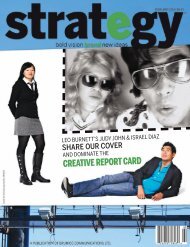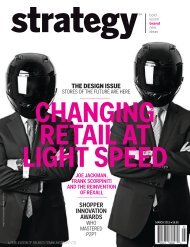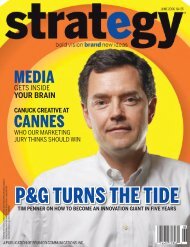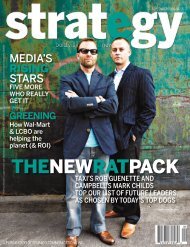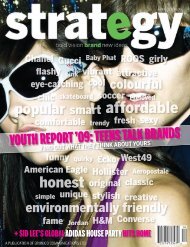TAXI DELIVERS KNOCKOUT PUNCH - Strategy
TAXI DELIVERS KNOCKOUT PUNCH - Strategy
TAXI DELIVERS KNOCKOUT PUNCH - Strategy
Create successful ePaper yourself
Turn your PDF publications into a flip-book with our unique Google optimized e-Paper software.
MITSUBISHI CANADA CANADA • BBDO • JEEP<br />
Mitsubishi was the newest player in the most hotly contested<br />
segment of the Canadian car market: small cars. Competing against<br />
established players like Hyundai and Kia, Mitsubishi needed to fi nd<br />
a stance that was both relevant and unclaimed. To add challenge to<br />
challenge, this had to be done with a budget that amounted to<br />
a 1.7% share-of-voice.<br />
BBDO found the answer in Mitsubishi’s heritage as a longtime<br />
winner in international rally racing, which suggested endurance, speed<br />
and agility. These weren’t just the attributes of a car – they were the<br />
attributes of an athlete.<br />
In terms of execution, the biggest challenge was in breaking<br />
category conventions. BBDO created a series of athletic-inspired<br />
spots culminating in the “Robots” creative, where assembly-line<br />
machines came to life to play a game of pick-up basketball. The<br />
campaign carried over into the interactive space with online banner<br />
ads in which a robot jams the wheel on a Mitsubishi car.<br />
Results were spectacular. Mitsubishi sales increased by 53% in<br />
2007, making it the fastest-growing player in the Canadian market.<br />
That growth has continued into 2008: through June, Mitsubishi<br />
achieved additional year-over-year sales growth of 18%, nearly eight<br />
times the industry average. The “Robots” creative was picked up by<br />
Mitsubishi USA, where it was tied into sponsorship of the NBA Finals.<br />
Within the increasingly competitive compact SUV class,<br />
Jeep was looking to create consumer demand around<br />
its new Wrangler model. While the basic body design had<br />
hardly changed since its inception, Jeep added two more<br />
doors and more room to this classic 4WD. The problem<br />
was that this innovation wasn’t inherently sexy to the<br />
consumer or differentiating for the brand.<br />
Jeep’s legendary ability to go to the most extreme parts<br />
of the world provided the creative inspiration to address<br />
the strategic challenge. Being able to take more people to<br />
remote parts of the world could have dire consequences<br />
– and this became the creative idea for the campaign.<br />
In a mixture of OOH, dealer posters and magazine<br />
advertising, three executions depicted the consequences<br />
of the insight: a grizzly bear, a lion and a python in remote<br />
locales benefi ting from the SUV’s new four-door feature.<br />
The super read: “The fi ve-passenger Wrangler Unlimited.<br />
Bringing more people to more remote places.”<br />
The media selection dovetailed with the extreme<br />
creative approach, choosing irreverent publications like<br />
Vice, Maxim and Now magazines.<br />
The creative work has been recognized internationally<br />
and at home (winning at D&AD, One Show, Clios and<br />
Obies, and shortlisted at Cannes), and the Jeep Wrangler<br />
continues to grow in its segment. The campaign ran in<br />
collaboration with retail sales support which resulted in<br />
a 54% lift for the total Jeep Wrangler brand during the<br />
fi rst six months from launch, in the same year that new<br />
or redesigned compact SUVs were launched from eight<br />
other auto companies.<br />
STRATEGY November 2008 37



